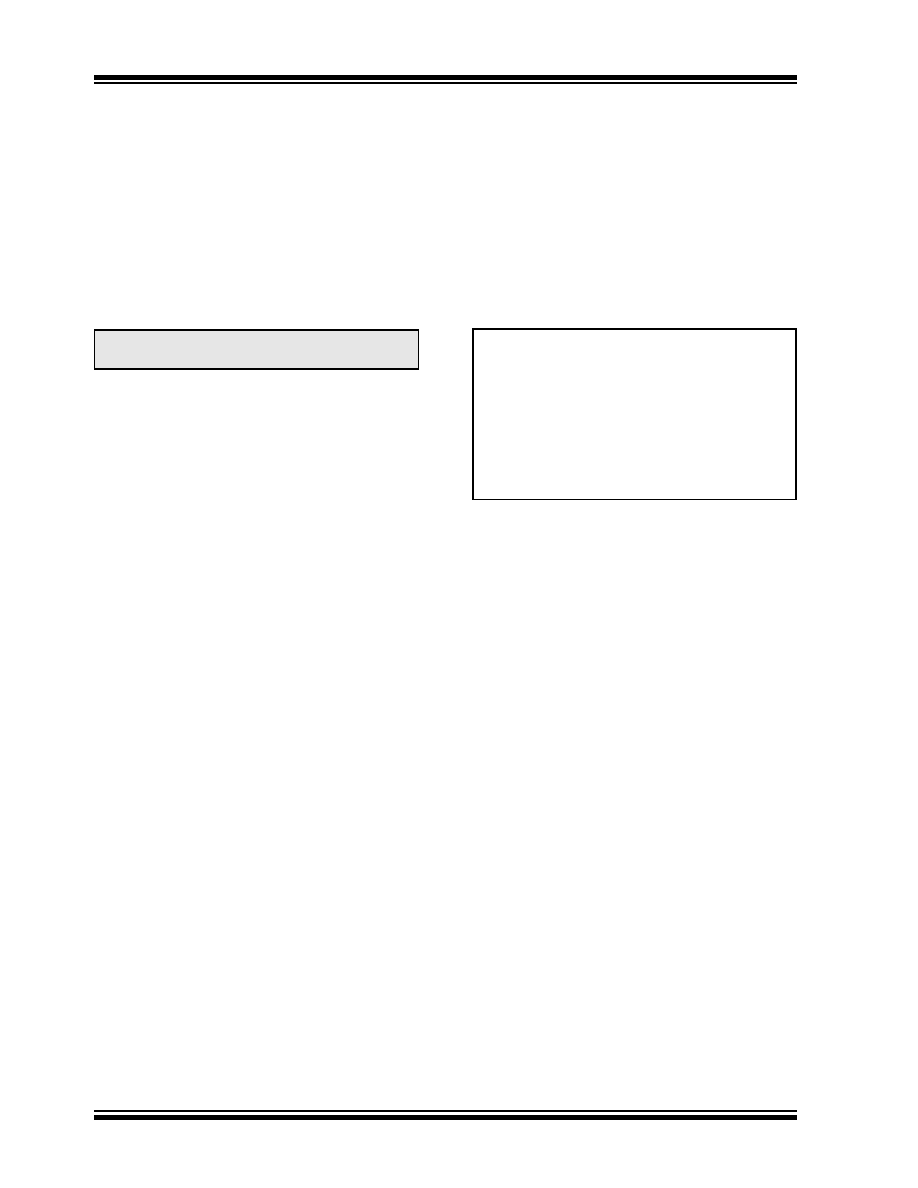- 您现在的位置:买卖IC网 > Sheet目录3871 > PIC18F83J11T-I/PT (Microchip Technology)IC PIC MCU FLASH 4KX16 80TQFP

PIC18F85J11 FAMILY
DS39774D-page 140
2010 Microchip Technology Inc.
11.6
PORTE, TRISE and
LATE Registers
PORTE is an 8-bit wide, bidirectional port. The corre-
sponding Data Direction and Output Latch registers are
TRISE and LATE. All pins on PORTE are digital only
and tolerate voltages up to 5.5V.
All pins on PORTE are implemented with Schmitt Trig-
ger input buffers. Each pin is individually configurable
as an input or output. The RE7 pin is also configurable
for open-drain output when CCP2 is active on this pin.
Open-drain configuration is selected by setting the
CCP2OD control bit (TRISG<6>)
Each of the PORTE pins has a weak internal pull-up. A
single control bit can turn off all the pull-ups. This is
performed by clearing bit, REPU (PORTG<6>). The
weak pull-up is automatically turned off when the port
pin is configured as an output. The pull-ups are
disabled on any device Reset.
On 80-pin devices, PORTE is multiplexed with the
system bus as part of the external memory interface.
I/O port and other functions are only available when the
interface is disabled by setting the EBDIS bit
(MEMCON<7>). When the interface is enabled,
PORTE is the high-order byte of the multiplexed
address/data bus (AD<15:8>). The TRISE bits are also
overridden.
When the Parallel Slave Port is active on PORTD, three
of the PORTE pins (RE0, RE1 and RE2) are configured
as digital control inputs for the port. The control
functions are summarized in Table 11-11. The reconfig-
uration occurs automatically when the PSPMODE
control bit (PSPCON<4>) is set. Users must still make
certain the corresponding TRISE bits are set to
configure these pins as digital inputs.
RE7 can also be configured as the alternate peripheral
pin for the CCP2 module. This is done by clearing the
CCP2MX Configuration bit.
EXAMPLE 11-5:
INITIALIZING PORTE
Note:
These pins are configured as digital inputs
on any device Reset.
CLRF
PORTE
; Initialize PORTE by
; clearing output
; data latches
CLRF
LATE
; Alternate method
; to clear output
; data latches
MOVLW
03h
; Value used to
; initialize data
; direction
MOVWF
TRISE
; Set RE<1:0> as inputs
; RE<7:2> as outputs
发布紧急采购,3分钟左右您将得到回复。
相关PDF资料
PIC16LF627-04/P
IC MCU FLASH 1KX14 COMP 18DIP
PIC18F86J55T-I/PT
IC PIC MCU FLASH 48KX16 80TQFP
PIC18F43K22-I/MV
MCU PIC 8KB FLASH 40QFN
PIC16C55A-04I/P
IC MCU OTP 512X12 28DIP
PIC18LF43K22-I/MV
MCU PIC 8KB FLASH 40UQFN
PIC16C622A-20I/P
IC MCU OTP 2KX14 COMP 18DIP
PIC18F84J11T-I/PT
IC PIC MCU FLASH 8KX16 80TQFP
PIC18F24K22-I/SP
IC PIC MCU 16KB FLASH 28SPDIP
相关代理商/技术参数
PIC18F83J90-I/PT
功能描述:8位微控制器 -MCU 8KB FL 1024b RAM 67I/O 8b Fam RoHS:否 制造商:Silicon Labs 核心:8051 处理器系列:C8051F39x 数据总线宽度:8 bit 最大时钟频率:50 MHz 程序存储器大小:16 KB 数据 RAM 大小:1 KB 片上 ADC:Yes 工作电源电压:1.8 V to 3.6 V 工作温度范围:- 40 C to + 105 C 封装 / 箱体:QFN-20 安装风格:SMD/SMT
PIC18F83J90T-I/PT
功能描述:8位微控制器 -MCU 8KB Flash 1024bytes-RAM 67I/O RoHS:否 制造商:Silicon Labs 核心:8051 处理器系列:C8051F39x 数据总线宽度:8 bit 最大时钟频率:50 MHz 程序存储器大小:16 KB 数据 RAM 大小:1 KB 片上 ADC:Yes 工作电源电压:1.8 V to 3.6 V 工作温度范围:- 40 C to + 105 C 封装 / 箱体:QFN-20 安装风格:SMD/SMT
PIC18F8410-E/PT
功能描述:8位微控制器 -MCU 16kBF 768RM 70I/O RoHS:否 制造商:Silicon Labs 核心:8051 处理器系列:C8051F39x 数据总线宽度:8 bit 最大时钟频率:50 MHz 程序存储器大小:16 KB 数据 RAM 大小:1 KB 片上 ADC:Yes 工作电源电压:1.8 V to 3.6 V 工作温度范围:- 40 C to + 105 C 封装 / 箱体:QFN-20 安装风格:SMD/SMT
PIC18F8410-I/PT
功能描述:8位微控制器 -MCU 16kBF 768RM 70I/O RoHS:否 制造商:Silicon Labs 核心:8051 处理器系列:C8051F39x 数据总线宽度:8 bit 最大时钟频率:50 MHz 程序存储器大小:16 KB 数据 RAM 大小:1 KB 片上 ADC:Yes 工作电源电压:1.8 V to 3.6 V 工作温度范围:- 40 C to + 105 C 封装 / 箱体:QFN-20 安装风格:SMD/SMT
PIC18F8410T-I/PT
功能描述:8位微控制器 -MCU 16kBF 768RM 70I/O RoHS:否 制造商:Silicon Labs 核心:8051 处理器系列:C8051F39x 数据总线宽度:8 bit 最大时钟频率:50 MHz 程序存储器大小:16 KB 数据 RAM 大小:1 KB 片上 ADC:Yes 工作电源电压:1.8 V to 3.6 V 工作温度范围:- 40 C to + 105 C 封装 / 箱体:QFN-20 安装风格:SMD/SMT
PIC18F8490-E/PT
功能描述:8位微控制器 -MCU 16kBF 768RM 66I/O RoHS:否 制造商:Silicon Labs 核心:8051 处理器系列:C8051F39x 数据总线宽度:8 bit 最大时钟频率:50 MHz 程序存储器大小:16 KB 数据 RAM 大小:1 KB 片上 ADC:Yes 工作电源电压:1.8 V to 3.6 V 工作温度范围:- 40 C to + 105 C 封装 / 箱体:QFN-20 安装风格:SMD/SMT
PIC18F8490-I/PT
功能描述:8位微控制器 -MCU 16kBF 768RM 66I/O RoHS:否 制造商:Silicon Labs 核心:8051 处理器系列:C8051F39x 数据总线宽度:8 bit 最大时钟频率:50 MHz 程序存储器大小:16 KB 数据 RAM 大小:1 KB 片上 ADC:Yes 工作电源电压:1.8 V to 3.6 V 工作温度范围:- 40 C to + 105 C 封装 / 箱体:QFN-20 安装风格:SMD/SMT
PIC18F8490-I/PT
制造商:Microchip Technology Inc 功能描述:IC 8BIT FLASH MCU 18F8490 TQFP80